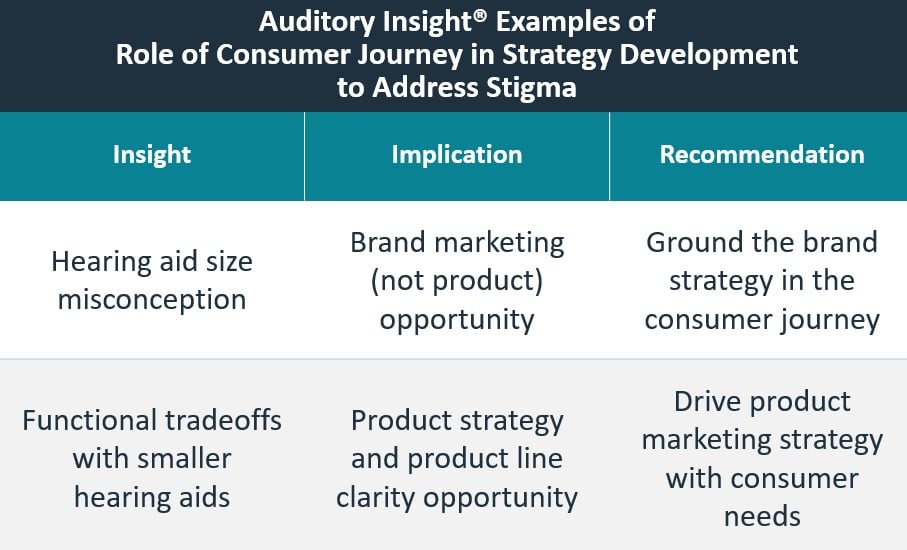by Nancy M. Williams, President of Auditory Insight
The fear of being stigmatized by society for being different, by making their hearing loss visible by wearing hearing aids, prevents at least a quarter of people diagnosed with hearing loss from obtaining hearing aids. How can hearing aid companies address this intractable barrier to care?
Insights from the consumer journey can serve as the foundation for creating market development strategies to address stigma. Yet in our experience, executives may underestimate the scope and strategic significance of the consumer journey.
We see the journey as comprehensive: the journey begins the moment the consumer first suspects hearing loss, continues through diagnosis and treatment, proceeds to acclimatization to hearing aids, and concludes in an ongoing phase we call Integration. Our proprietary framework uses multiple dimensions of the journey in behavioral, psychological, and structural domains. Most importantly, we believe that the primary source of the journey needs to be consumers themselves.
My recent conversations with three leading audiologists provide two examples of how insights from the consumer journey translate into concrete strategy for addressing stigma. We summarize those insights in the table below and then elaborate on each.

Hearing aids’ size misconception
Many new consumers come into their first appointment with a perception of devices as obtrusive and oversized. “Usually they are pleasantly surprised when you put the hearing aids in their ear and take a picture” to show them, reports Dr. Kathleen Wallace of Anywhere Audiology.
Similarly, Dr. Elizabeth Thompson, president and founder of Hickory Audiology, has a display of hearing aids in their charging cases right behind her desk, visible to people when she presents hearing test results. She often catches them looking over her shoulder, staring at the hearing aids. “People ask, ‘Is that it?’”
To which she replies, “That small thing? Yeah, that’s it.”
Brand (not product) marketing has an opportunity
My company’s analysis indicates that stigma is the number two reason (after price) why consumers diagnosed with hearing loss by a hearing care professional (HCP) do not adopt hearing aids. Echoing Wallace and Thompson’s patients, consumers provide reasons such as they are embarrassed to wear hearing aids or admit their hearing loss in public, per our analysis of the Hearing Industries Association MT 2022 data.
The implication is that hearing aid companies’ brand marketing teams face an important opportunity to impact consumer perceptions at the specific point in time when they are deciding whether to pursue care.
We believe that the industry’s current focus on product marketing is not sufficient to combat stereotypes feeding stigma.
Ground brand strategy in the consumer journey
Creating a brand strategy to address an intractable aspect of society like stigma is no small task. The first step in creating an effective brand strategy is to ground it in the consumer journey with hearing loss.
Of particular interest for brand strategy is the first journey stage, which we call “Awareness.” The Awareness stage encompasses when people first suspect their hearing loss until they undergo a hearing test with an HCP. It’s during Awareness that consumers first grapple with the threat of stigma in society and consider their own social identity. Consumers continue to contend with stigma as they continue on their journey.
In sum, an in-depth understanding of consumers’ experiences with stigma provides companies with specific insight to create effective brand marketing strategies.
Less visible hearing aids have functional product tradeoffs
For consumers who want less visible devices, HCPs need to explain the significant tradeoffs between standard behind-the-ear (BTE) hearing aids versus smaller completely-in-canal (CIC) and invisible-in-canal (IIC) models. These smaller models often lack Bluetooth connectivity, useful for phone calls and streaming music from the hearing aid, as well as rechargeable batteries. “IICs are very hard to do,” reports Dr. Wallace. “You can’t fit much power into them and the battery drains in three days.”
Fitting CICs and IICs often takes more time and expertise than BTEs. “You have to have a perfect fit,” Dr. Judy Huch explains. “You need a seal in the bony portion of the ear canal. Otherwise you will have an occlusion effect.” For one client, she had to take new impressions of the ear canal six times. Dr. Huch is president of Oro Valley Audiology and founder of Grace Hearing Center, a nonprofit hearing center for low-income adults and under-served children.

Marketing needs to establish product line clarity
Most consumers arrive for their first HCP appointment unaware of the tradeoffs between BTEs and the less visible CICs and invisible IICs. Meanwhile many HCPs focus on maximizing hearing outcomes and device functionality. They may not fully appreciate the importance to consumers of these less visible devices in allaying fears of stigma.
Product line clarity, based on an overarching product strategy, would clear up this market confusion. Yet many hearing aid companies simply list the products in their line. Those that group products tend to do so based on device form factor or technical platform. Unfortunately, these lists and groupings do not provide much direction to consumers with specific needs nor to HCPs trying to solve those needs.
Consumer needs should drive product strategy
Hearing aid companies can create clarity for both consumers and HCPs by presenting their product line in terms of consumer needs. How hearing aid companies communicate their product line to HCPs in turn impacts how clinicians describe hearing aids to consumers. Consumers evaluating hearing aids are looking to solve specific hearing problems, including addressing societal stigma. We believe that leading with lifestyle benefits that hearing aids provide—not the features and technology—is the best way to increase hearing aid adoption.
An effective product marketing strategy that communicates tangible benefits depends on a deep understanding of the consumer journey with hearing loss. Consumers’ needs and barriers along the entire journey, from the first inkling of hearing loss until integration of the device into their daily lives, are applicable.
Conclusion
At my company, we believe in the criticality of leveraging the consumer journey with hearing loss to address stigma. This article provides two examples of how understanding the consumer journey can tackle stigma and increase adoption, by impacting brand strategy and product marketing strategy. These examples underscore our recommendation that insights from the consumer journey should contribute to hearing aid companies’ full range of strategic decisions.







